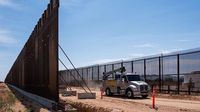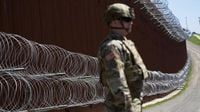On August 19, 2025, Homeland Security Secretary Kristi Noem stood before the towering steel slats of the U.S.-Mexico border wall in Santa Teresa, New Mexico, roller brush in hand. Her message was clear and direct: the entire southern border wall will be painted black, a move she credited to President Donald Trump himself. The aim—according to Noem and echoed by administration officials—is to make the wall so hot under the desert sun that it becomes nearly impossible to climb, thus deterring illegal crossings.
“That is specifically at the request of the president, who understands that in the hot temperatures down here, when something is painted black, it gets even warmer and it will make it even harder for people to climb,” Noem told reporters, as cited by ABC 10News and CNN. She added, “We are going to be painting the entire southern border wall black to make sure that we encourage individuals to not come into our country illegally.”
The plan is more than just a cosmetic change. Noem emphasized the wall’s imposing physical characteristics: “It’s tall, which makes it very, very difficult to climb, almost impossible. It also goes deep into the ground, which would make it very difficult, if not impossible, to dig under.” The black paint, she explained, is another layer of deterrence—one that leverages the relentless heat of the Southwest.
U.S. Border Patrol Chief Mike Banks, who joined Noem at the border, pointed out another benefit: the black paint will help prevent rust on the steel, potentially extending the wall’s lifespan. “The paint will also help deter rust,” Banks noted, according to AP and BBC.
The idea to paint the wall black is not new. Reports of such plans first surfaced during Trump’s first term, with tests of black coatings on certain sections of the wall as early as 2020. Back then, some officials questioned the operational value of the paint, suggesting it was largely to fulfill the president’s personal preference. But now, with Trump back in the White House, the plan is being implemented in earnest—and on a grand scale.
Funding for the project is substantial. Congress passed what’s been dubbed the “One Big Beautiful Bill Act” earlier this summer, allocating nearly $47 billion for continued wall construction, painting, and maintenance. The Department of Homeland Security has been tight-lipped about the specific costs for painting, citing an active procurement process and the need to protect taxpayer interests during bidding. “Due to an active procurement process to finish the wall it would be irresponsible to the American taxpayer to release the numbers as it may impact future bids,” a DHS spokesperson told Axios.
Construction is moving at a brisk pace, with about half a mile of new barrier being erected every day along the nearly 2,000-mile border. Noem described the wall as a dynamic structure: “The border wall will look very different based on the topography and the geography of where it is built,” she explained, referencing the unique challenges posed by deserts, mountains, and the vast stretches of the Rio Grande River.
The administration is not stopping at just the wall. Noem announced plans for additional “water-borne infrastructure” along the Rio Grande, which forms more than half of the border between the two countries. While she did not provide specific details, previous efforts in Texas have included floating barriers—large orange buoys—and reinforced fencing along riverbanks, guarded by state troopers and the National Guard.
Technological upgrades are also in the works. “There will be more added to it as far as technology, cameras, sensors—we’re also going to be painting it black,” Noem said, highlighting the administration’s push for a modernized, multi-layered approach to border security.
The policy shift comes as illegal border crossings have plummeted to record lows. According to figures released by the administration and reported by BBC and CNN, apprehensions at the southern border dropped to just over 6,000 in June and 4,600 in July—a 92% reduction compared to the previous year. In contrast, during the Biden administration, detentions sometimes spiked to averages of 6,000 per day.
The Trump administration credits increased border security, mass deportations, and the deterrent effect of the wall for the dramatic decline. White House Press Secretary Karoline Leavitt said earlier in August that a total of 300,000 undocumented immigrants had been detained in the interior of the U.S. since January. Noem added that 1.6 million undocumented immigrants have left the country during the first 200 days of Trump’s second term, though she did not specify how many were deported versus left voluntarily.
However, not everyone is convinced the black paint will have the intended effect. Immigration advocates, like Pedro Rios of the American Friends Service Committee, question both the effectiveness and the cost of the project. “People could wear gloves, they can climb at night when the border wall is no longer hotter,” Rios told ABC 10News. “It’s just an erroneous logic to present, and that does not respond to the humanitarian needs that people have who are seeking to migrate to the United States.”
Some critics within U.S. Customs and Border Protection have also reportedly argued that the painted finish would have little operational benefit, suggesting the move is more symbolic than substantive. Yet, for supporters of the administration’s hardline approach, the black wall stands as a visible testament to a renewed commitment to border security.
The border wall itself has become an enduring symbol of Trump’s political brand. It was a centerpiece of his first campaign and administration, with prototypes tested in places like Otay Mesa, California. Since then, the wall has been the site of both attempted breaches—people cutting through or destroying sections—and intense political debate.
As construction continues and the painting project gets underway, the southern border is being transformed once again—not just by policy, but by the very color of its most visible barrier. Whether the black paint will truly deter would-be crossers or simply serve as another chapter in the ongoing story of America’s border remains to be seen. For now, the administration is pressing ahead, brush in hand, determined to finish what it started.






